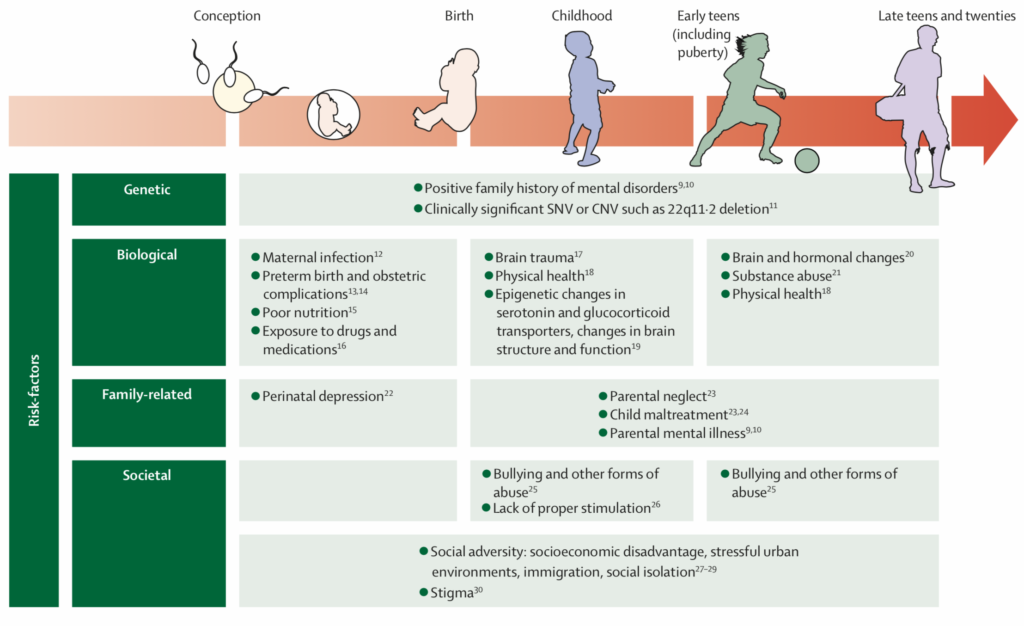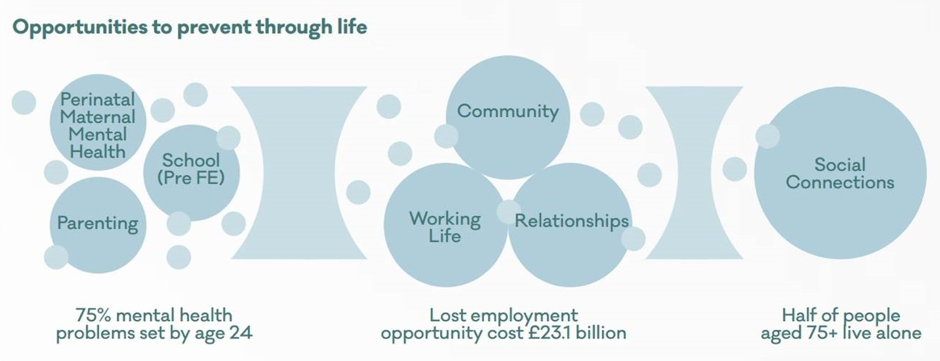
It’s time to take action to prevent mental health problems from occurring. Science has come to a stage where we are starting to uncover what we can do to prevent, for whom and when.
In 2015, rapid review (landscaping paper) conducted by the Mental Health Foundation looked at the current state of the evidence and showed that there are still gaps for certain population groups and at certain stages during the life course (Mental Health Foundation, 2015). The next step is to improve our understanding of these at-risk groups and look at indicated prevention strategies.
There are various stakeholders and academic fields of expertise (i.e. public health, psychology, sociology, psychiatry) aiming to further understand prevention. A new review published yesterday in The Lancet Psychiatry explores the role that psychiatry can play in improving our understanding of how best to prevent mental health conditions (Arango et al, 2018).
The paper summarises and reviews the current state of the art on prevention of mental health problems. The authors start by highlighting the implementation challenge and suggest there is still a gap between our knowledge about risk factors and how we have thus far been able to translate this to clinical practice.

Prevention efforts can best address multiple cumulative risk factors at an early stage of development.
What is prevention?
The review focuses on the current state of the art on prevention and starts with a definition and overview:
Prevention in mental health aims to reduce the incidence, prevalence, and recurrence of mental health disorders and their associated disability. Preventive interventions are based on modifying risk exposure and strengthening the coping mechanisms of the individual.
What are likely risk factors for developing a mental health problem?
The article discusses the risk factors for developing mental health problems including genetic, environmental (pre and post-natal), social risks, trauma, insufficient stimulation, general adversity and stressful life events, and drug abuse. The list for risk factors given did not aim to cover all risk related to developing mental health problems and highlighted that such factors are often related and can create synergistic effects.

Risk factors for mental disorders. Taken from Arango et al (2018).
What can we do to move the field forward?
The authors present their key prevention messages. They provide an overview of the current challenges for prevention as well as recommendations for future practice and research.
The authors recommend investing during critical periods of development (the prenatal period, childhood, and adolescence through early adulthood) and to focus on building resilience.
All key messages for prevention are:
- Translate scientific evidence for cost-effective preventive interventions into public health initiatives, clinical practice, and service delivery systems
- Increase social, professional, and political awareness of advancements and the importance of mental health prevention and promotion
- Move clinical practice toward at-risk-oriented detection and intervention
- Provide interventions designed for each developmental stage aimed at minimising the impact of risk factors
- Promote interventions with a multidisciplinary and multilevel (psychological, social, familial, and legal) approach
- Promote healthy lifestyles including nutrition and exercise
- Encourage school-based interventions (targeting children, parents, and education professionals).

Increasing evidence supports the efficacy of universal and selective preventive interventions to promote mental wellbeing and prevent mental disorders throughout development.
Limitations
The authors provide a comprehensive overview of risk factors but could also focus on the increased risk that people in later life have and other stressful transition points where people are at higher risk. We need to be careful not to only focus on the perinatal period, children and young adults and lose sight of the number of people who are currently in adulthood or later life at risk of development. The focus on prevention needs to occur across the life course and at key transition points.
Further, individual biological and psychological changes highlighted in the piece are important factors. However, the emphasis on social connection and the interaction between the social environment and certain biological change would, in my view, also be a recommendation on its own. Whilst challenging to evaluate in randomised controlled trials, strengthening communities and social connection may be promising avenues for future interventions and approaches.

Taking a life course approach and exploring social connections. Source: www.mentalhealth.org.uk
Conclusions
The authors provide an overview of the literature on prevention with many recommendations for practice, research and policy. I found it helpful that the role of mental health professionals was discussed and how they can play a part in identifying risk, early intervention and raising awareness for prevention with other professional disciplines.
These papers always leave one wondering: what is the key take-home message? For me, it’s looking at collaboration between scientific disciplines, professional groups, policy makers and most importantly involving the public throughout; in the end it’s an issue we have to tackle together.

Let’s push for greater collaboration between scientific disciplines, professional groups, policy makers and most importantly involving the public throughout.
The lead author of this review (Professor Celso Arango) gave a talk entitled: “Prevention in mental health, a train we should not miss. Not again” at the #MQScienceMeeting in London in Feb 2018, which we covered with our #BeyondTheRoom service. You can look back at the live tweeting here.
Links
Primary paper
Arango C, Díaz-Caneja CM, McGorry PD, Rapoport J, Sommer IE, Vorstman JA, McDaid D, Marín O, Serrano-Drozdowskyj E, Freedman R, Carpenter W. (2018) Preventive strategies for mental health. The Lancet Psychiatry Published Online May 14, 2018
Other references
Mental Health Foundation (2015) Prevention review: landscape paper. Mental Health Foundation, Nov 2015.
Photo credits
- Photo by Jelleke Vanooteghem on Unsplash
- Photo by Samuel Owoyemi on Unsplash
- Photo by “My Life Through A Lens” on Unsplash

yes, as the title says, what can we do? actually do?
what can my friend who gave birth this week do for her child, to maximise it’s prospects of having good lifelong mental health?
Hi John,
I think the advice you would give a new parent about the mental wellbeing of their new child is similar to the advice you would give them about general wellbeing. The NHS baby guide contains some useful information about anxiety and difficult behaviour in toddlers: https://www.nhs.uk/conditions/pregnancy-and-baby/?tabname=babies-and-toddlers
YoungMinds have a good page on infant mental health: https://youngminds.org.uk/find-help/for-parents/parents-guide-to-support-a-z/parents-guide-to-support-infant-mental-health-babies-and-under-5s/
These Youth Mental Health books on prescription might also be helpful for older children: https://reading-well.org.uk/books/books-on-prescription/young-people-s-mental-health/general
Cheers,
André
For a critical reaction to some of these ideas, please visit my blogsite http://www.mentalhealthconspiracy.com
[…] cost, easy to implement strategies to improve mental health and wellbeing. In her Mental Elf Blog (Preventing mental health problems: what can we do?), Josefine Breedvelt discusses prevention as one of the key ideas for a cost effective solution is […]
[…] (Read more about ways on preventing mental health problems here: https://www.nationalelfservice.net/treatment/mental-illness-prevention/preventing-mental-health-prob…) […]
my mother is suffering frm behaviour change frm past 25 years.. aftr every 6-8 months or aftr 2-3yrs.. it always happens on season change.. changes such as taking about 30 -35 yrs old things.. being angry on little little things.. she does not know what she is tlking.. its much more.. pls suggest something
No mention of Adverse Childhood Experiences (ACEs – traumas), or did I miss something?
My friend is suffering by mental diseases..(Anxiety, depression).. She is always crying when any negative events happen in her life. She can’t tolerate the painful problems which are related to her parents. (Eg. Parents scold her.. Etc. ).she usually suffers exam fear. Now,she takes medicine. But, she can not get enough relief from this disease. Sometimes, she thinks about suicide. What is the solutin for this problem?